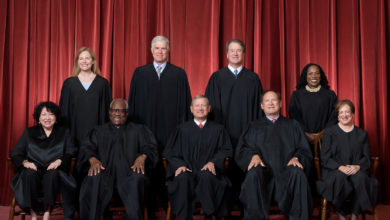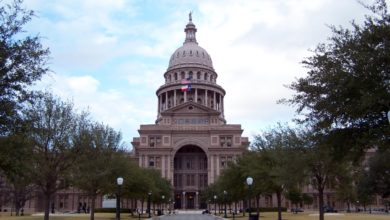Photo: Protesters outside the Supreme Court as hearings in the Moore v. Harper case were held
In a 6 to 3 ruling, the Supreme Court rejected the arguments brought by the head of the North Carolina state legislature in the pivotal case Moore v. Harper. The case revolved around a racist, gerrymandered map of the state’s congressional districts, which was thrown out by the state Supreme Court in February 2022. But the state legislature challenged this decision in federal court, arguing that virtually no institution of government had the right to overturn any decision it made regarding federal elections. Even though the North Carolina Supreme Court later reversed its decision in April of this year and accepted the rigged congressional district map after a right-wing majority was elected, the U.S. Supreme Court went ahead and issued a ruling based on the arguments brought forward in the initial case.
What made this case particularly dangerous was that the defense of the rigged map was based on a doctrine called the independent state legislature theory. As the book “The Supreme Court versus Democracy” explains:
“It appeared somewhat as a fringe theory a couple of years ago when Trump’s lawyers first advanced it, but, like so much else, it has received a larger adoption within the Republican Party … Trump and his army of right-wing operatives argued that the state legislatures dominated by the Republican Party could determine which group of electors would be sent to the Electoral College. They cited the ‘Presidential Electors Clause’ in the Constitution which reads, ‘Each State shall appoint, in such Manner as the Legislature thereof may direct, a Number of Electors.’ … Under this interpretation, the state legislature’s decisions related to federal elections cannot be challenged or overturned by the governor, state supreme court, state constitution, or even the federal government.”
If the independent state legislature theory were upheld, then even if the voters of a state chose one candidate, the state legislature could decide to assign the state’s electoral college votes to the other candidate based on false allegations of fraud like in 2020, or any other pretext.
The majority opinion in today’s ruling rejected the independent state legislature theory and affirmed the right of courts to review decisions on matters pertaining to elections. But this is not the result of some miraculous change of heart on the part of the hardline reactionary justices. The Supreme Court makes decisions based on political calculations.
The very legitimacy of the Supreme Court as an institution has been called into question by the right-wing rampage it went on in last year’s term. The centerpiece of a long string of rulings that trampled on basic rights was the Dobbs decision that shredded the right to abortion. This provoked outrage across society, and tens of thousands took to the streets in protest. There was also an unmistakable electoral expression of this indignation. Despite Biden’s deep unpopularity and a spiraling inflation crisis, Democrats managed to hold on to control of the Senate and limit Republican control of the House to the narrowest of majorities. In a number of state referendums, pro-choice positions prevailed even in right-wing dominated areas like Kansas, Kentucky and Montana.
The Supreme Court cherishes its false image as an “apolitical” arbiter of right and wrong, interpreting the Constitution faithfully in line with the rule of law. The extreme character of the Dobbs decision and other outrageous rulings punctured this image in a major way. A Gallup poll released last June, for example, found that only 25 percent of Americans had “a great deal” or “quite a lot” of confidence in the Supreme Court as an institution — in recent years this figure had hovered around 40%. A poll taken in September found that this delegitimization had spread to the judiciary as a whole, with only 47% saying they had “a great deal” or “a fair amount” of trust in the judicial branch of the federal government. Both of these figures were the lowest on record since Gallup began asking the question in the early 1970s.
And since then, egregious corruption scandals have even further eroded the standing of the Supreme Court in society. Far-right justices Samuel Alito and Clarence Thomas have both been exposed as having received gifts like luxury vacations from billionaire businessmen whose personal and political interests were affected by matters before the court.
The right-wing super majority on the court may be dividing into two camps. Alito, Thomas and Neil Gorsuch appear willing to press on with a frontal attack on basic democratic rights. But John Roberts, Amy Coney Barrett and Brett Kavanaugh appear more willing to ease up at certain moments in the interest of preserving the long-term credibility of the court. These three joined with the three liberal justices to form the majority bloc in the Moore v. Harper ruling.
But this does not mean that the threat to democratic rights has passed. Whether it takes the form of a revival of the independent state legislature theory, an intensification of the disenfranchisement of Black voters, or any other mechanism, the Supreme Court could decide at any moment to resume their all-out offensive against democracy. And their campaign to roll back progressive reforms continues. Later this week, rulings are expected that could eliminate affirmative action and plunge millions of people deeper into student debt. The Supreme Court is as illegitimate as ever: Nine millionaire judges serving lifetime terms, elected by no one and loyal only to the ruling class.






